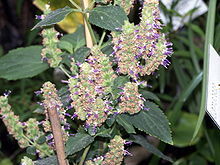| Patchouli | |
|---|---|

| |
| Scientific classification | |
| Kingdom: | Plantae |
| Clade: | Tracheophytes |
| Clade: | Angiosperms |
| Clade: | Eudicots |
| Clade: | Asterids |
| Order: | Lamiales |
| Family: | Lamiaceae |
| Genus: | Pogostemon |
| Species: | P. cablin
|
| Binomial name | |
| Pogostemon cablin (Blanco) Benth.
| |
Patchouli (also spelled patchouly or pachouli) (/pəˈtʃuːli/; Pogostemon cablin) is a species of flowering plant in the family Lamiaceae, commonly called the mint or deadnettle family. The plant grows as a bushy perennial herb, with erect stems reaching up to 75 centimetres (30 in) in height and bearing small, pale, pink-white flowers.
It is native to the island region of Southeast Asia, including Sri Lanka, Indonesia, the Malay Peninsula, New Guinea, and the Philippines. It is also found in many parts of North East India.[1] Noted for its fragrant essential oil, it has many commercial uses and is now extensively cultivated in tropical climates around the world, especially in Asia, Madagascar, South America, and the Caribbean. As of 2023[update], global demand for patchouli oil is over 1,600 metric tons (1,600 long tons; 1,800 short tons) per year, of which over 90% is produced by Indonesia.
- ^ "Pogostemon cablin (Blanco) Benth". Plants Of the World Online.